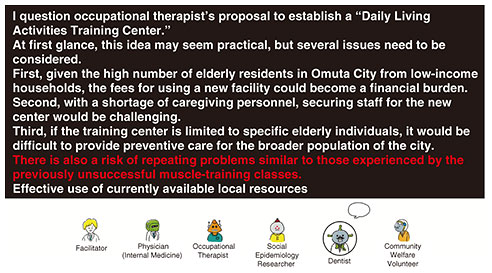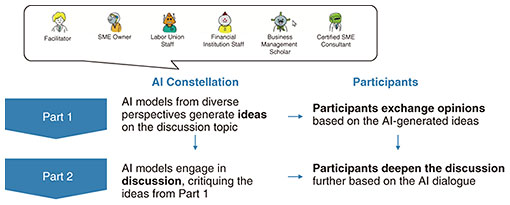 |
|||||
|
|
|||||
|
Feature Articles: AI Constellation—Toward a World in Which People and AI Work Together Vol. 23, No. 11, pp. 34–39, Nov. 2025. https://doi.org/10.53829/ntr202511fa3 Field Trial and Future Outlook of AI ConstellationAbstractThis article introduces a field trial of AI Constellation—a large-scale artificial intelligence (AI) collaboration technology—titled “Conference Singularity,” held in Omuta City, Fukuoka Prefecture. Through AI-to-AI discussions using AI Constellation, we explored how ideas and opinions from diverse perspectives can be generated around complex issues, such as regional challenges, which lack a single solution due to differing stakeholder viewpoints. The trial confirmed that this approach can help deepen human discussion and lead to concrete new insights. Keywords: AI Constellation, large language model, enhanced discussion 1. IntroductionAI Constellation, which is a large-scale artificial intelligence (AI) collaboration technology promoted by NTT, is aimed at solving complex problems that have varying solutions depending on perspective. One particularly promising use case is the enhancement of discussions within communities. In organizational decision-making, whether in companies or municipalities, AI-to-AI discussions can surface perspectives and ideas that may not naturally emerge in human-only discussions. This, in turn, can elevate the overall level of the dialogue. In this article, we introduce a field trial titled “Conference Singularity,” which was conducted to evaluate whether discussions among AIs can stimulate and enrich human discussion. In this trial, AI Constellation was applied to local community issues and validated through a workshop format where relevant stakeholders held discussions. The following sections describe the current state of discourse in local communities that inspired the trial, the workshop experience design based on the strengths of AI Constellation, and the evaluation results of the field trial. 2. Discussion forums in local communities and their characteristicsIn designing the field trial, we first analyzed the current state of discussion forums within local communities in Japan. Broadly speaking, there are four main types of forums commonly used for public discourse. From interviews with stakeholders, we identified key characteristics and challenges for each type. 2.1 Town hall meetings/workshops
2.2 Deliberative councils (Shingikai)
2.3 Advisory committees (Kyōgikai)
2.4 Decision-making bodies
3. Designing the field trial experienceOn the basis of our assessment of the current state of discussion forums within local communities, we found that applying AI Constellation to settings such as town meetings and workshops, where residents engage in open, egalitarian dialogue, would be the most effective way to evaluate its impact on revitalizing community discourse. Accordingly, we decided to conduct the field trial in the format of a workshop. At the same time, given the difficulty of sparking lively discussion in conventional workshops, we consulted with experts and incorporated the following perspectives into the experience design:
With such a design, AI is not positioned as something that replaces humans but as a tool to be tested, considered, and used in ways that draw out human potential. It also supports residents in discovering ways to leverage technology for community development. In conducting the workshop as a testbed for evaluating AI Constellation’s capabilities, it was also important to carefully manage the structure and operation of the event. We paid special attention to the following elements in designing the program:
Taking into account the above considerations in both experience design and operational planning, we proceeded to conduct the actual field trial. 4. Field trial: “Conference Singularity”The field trial of AI Constellation was held in Omuta City, Fukuoka Prefecture, on October 17, 2024, under the title “Conference Singularity: Thinking with AIs about the future of Omuta” [1]. On the basis of the experience and program design prepared in advance, it was conducted in the form of a workshop. 4.1 Discussion themes and participantsThe workshop focused on two themes relevant to challenges commonly faced by local governments such as Omuta City: “Support for small and medium-sized enterprises (SMEs)” and “Preventive care for the elderly.” Participants were invited on the basis of their relevance to the themes, and residents with the following backgrounds took part: (1) SME Support (12 participants)
(2) Preventative Care for the Elderly (12 participants)
4.2 Design of AI ConstellationTo implement AI Constellation in this workshop, we incorporated the technologies described in the article “Research and Development toward AI Constellation” [2] and built a system capable of producing natural, concrete, and non-redundant comments tailored to the discussion themes. We also prepared the following personas, assigning each a role tailored to the respective discussion themes, as examples of AI models with domain-specific expertise: (1) SME Support
(2) Preventative Care for the Elderly
In addition to assigning roles similar to those of the human participants, we deliberately included personas for roles not represented in the group, allowing perspectives to emerge that would not have arisen from the participants’ viewpoints alone. In the large language models (LLMs) used by AI Constellation, such personas are typically implemented through prompts. However, providing too detailed or rigid prompts can result in narrow, overly role-bound outputs. Therefore, we designed concise prompts that provided only the role and general orientation of the persona. Example prompt 1: Certified SME Consultant
While LLMs have general knowledge, they do not inherently provide information relevant to the local context of Omuta. To address this, we supplemented the prompts with related local information, enabling participants to participate in discussions among AIs naturally. Example prompt 2: Local information on Omuta (1) Population (as of April 2024)
(2) Labor supply constraints
AI Constellation outputs appear as text only, lacking non-verbal cues. This presents a challenge in helping participants follow and engage with the discussion. To address this, we provided two user interfaces. First, a shared display screen visible to all participants was used by facilitators to guide the session in real time (Fig. 1). Second, a comment-history interface enabled participants to revisit AI-generated remarks during human-to-human discussions. These tools helped prevent common problems that often occur in standard discussions as well, such as losing track of the conversation or disproportionately reacting to the most recent statement.
4.3 Program structureTo encourage active discussion in a small-group setting, each group consisted of 3 to 4 participants seated around a round table. Dividing participants into smaller groups was intended to foster individual engagement and participation. While an overall facilitator guided the entire program, each group followed the discussion process outlined below (Fig. 2): 1. Using AI Constellation, AIs representing diverse perspectives generated ideas on the basis of the discussion theme. Participants viewed these AI-generated ideas then exchanged their opinions within the group. 2. AI Constellation then facilitated a second round of discussions in which the AIs critiqued the initial ideas in Part 1, each offering specific reasons for their criticism. Participants reviewed these critiques and, using the AI dialogue as a clue, deepened their discussions and worked toward identifying actionable policy ideas suited for Omuta.
This format intentionally avoided having humans and AI debate simultaneously. This structure, AI’s prior conversation prompting human discussions, was designed to discourage participants from defaulting to familiar discussion patterns and encourage them to focus on AI’s ideas and articulate their own opinions. Selecting AI’s ideas was intended to bring out their desire to express their opinions. Including a step where AIs critiquing each other’s ideas helped normalize an environment where disagreement with constructive reasons is permitted. This was particularly important in enabling individuals to feel comfortable expressing opinions in situations where hierarchy or social dynamics might normally inhibit open dialogue (e.g., therapists giving opinions to physicians). 5. Participant reactions to the “Conference Singularity”Following the workshop, we conducted a survey with all 24 participants to gauge their impressions of the AI Constellation discussion, focusing on whether the AI-generated remarks felt natural or specific and whether participants gained any new insights. The survey included the following two questions: 1. Q1: Did the AI-to-AI discussions provide you with new insights? 2. Q2: Do you think basing the human discussion on the AI conversation helped deepen the discussion? The results indicate strong support: for Q1, 7 participants answered “Very much so,” and 17 answered “Somewhat;” for Q2, 12 answered “Strongly agree,” and 12 answered “Somewhat agree.” This means 100% of respondents gave positive feedback, confirming that multi-AI discussions helped participants engage meaningfully and derive specific insights without discomfort. We also interviewed participants to better understand how they felt about using AI Constellation during the discussions. Key takeaways included:
Overall, the feedback confirms that the design of this field trial worked as intended, providing participants with a valuable and meaningful experience. 6. Conclusion and future outlookBy implementing the AI Constellation concept through the “Conference Singularity” field trial, we confirmed that this approach can effectively enhance the quality of human-to-human discussions. Rather than replacing humans, generative AI served as a partner that stimulated conversation and elevated its depth and quality. Moving forward, we aim to apply this concept to a broader range of discussions around regional challenges, as well as explore its use in corporate settings such as for meetings and strategic planning. Through these efforts, we will continue advancing research and development of AI Constellation to support and enhance a wide array of human intellectual activities. References
|
|||||













